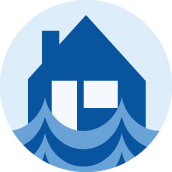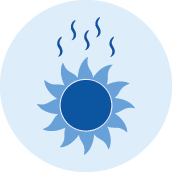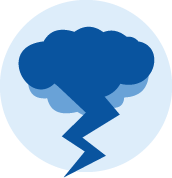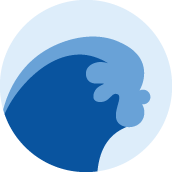FloodsNgā waipuke
Floods happen often in New Zealand and can cause a lot of damage and loss of life. Find out what to do before, during and after flooding.
On this page
Reduce the impacts of floods
Find out what the flood risk is in your area. Your local council may have resources and information on how to reduce potential flood damage.
Review your insurance regularly. Having insurance cover for your home and contents is important to help you get back on your feet if you suffer damage in a disaster.

We can't predict disasters, but we can prepare for them. One of the best places to start is with your home. Find out what you can do to make your home safer.
Get ready before a flood
Find out from your local council if your home or business is at risk from flooding and how they’ll alert you if you need to evacuate. Ask about:
- Evacuation plans and local public alerting systems
- What to do with your pets and livestock if you have to evacuate
- How you can reduce the risk of future flooding to your home or business
Work out what supplies you might need and make a plan together.
Practise your emergency plan and your evacuation route to higher ground.
Take measures to reduce potential flood damage and make sure your insurance policy covers you for flood damage.

In an emergency, you may be stuck at home for three days or more. Your house is already full of emergency items disguised as everyday things. Figure out what supplies you need and make a plan to get through.
What to do during a flood
Put safety first. Don’t take any chances. Act quickly if you see rising water.
Floods and flash floods can happen quickly. If you see rising water do not wait for official warnings. Head for higher ground and stay away from floodwater.
Stay out of flood water
Never try to walk, swim or drive through flood water. Many flood fatalities are caused by people attempting to drive through water.
Always assume that flood water is contaminated with farm run-off, chemicals and sewage. Contaminated flood water can make you sick. Make sure you wash your hands, clothes and property after contact with flood waters.
If flooding is possible:
Stay informed in an emergency. Listen to the radio or follow your Civil Defence Emergency Management Group online.
Be prepared to evacuate and keep your grab bag near. Listen to emergency services and local Civil Defence authorities. Follow any instructions about evacuation of your area. Self-evacuate if you feel unsafe.
Move pets to a safe place and move stock to higher ground. If you have to leave, take your pets with you. If it’s not safe for you, it’s not safe for them.
Turn off water, electricity and gas if advised to.
Move valuable and dangerous items as high above the floor as possible. This includes electrical equipment and chemicals. Use watertight containers to store important items.
Lift curtains, rugs and bedding off the floor.
Check on your neighbours and anyone who may need your help.

Find your local Civil Defence Emergency Management (CDEM) Group.
What to do after a flood
Only return home after Civil Defence and emergency services have told you it is safe to do so. It may not be safe to return home even when the floodwaters have receded.
Stay away from damaged areas. You might hamper rescue and other emergency operations and be at further risk from the residual effects of floods.
Look before you step. After a flood, the ground and floors may be slippery or covered with debris, including broken bottles and nails.
Help others if you can, especially people who may need extra help.
If your property is damaged
- Do not do anything that puts your safety at risk or causes more damage to your property.
- Contact your insurance company as soon as possible.
- If you rent your property, contact your landlord and your contents insurance company.
- Take photos of any damage. It will help speed up assessments of your claims.
Food safety after a flood
Throw away food and drinking water that has come into contact with floodwater, including canned goods.
Avoid drinking or preparing food with tap water until you are certain it is not contaminated. Follow any boil water notice instructions from your local authorities.
For more information on food safety during and after an emergency visit the Ministry for Primary Industries website.
Cleaning up after a flood
Clean and dry your house and everything in it. Floodwater can make the air in your home unhealthy. When things get wet for more than two days they usually get mouldy. There may also be germs and bugs in your home after a flood.
Mould may make some people with asthma, allergies or other breathing problems sick.
Talk to your doctor or another medical professional if you have questions about cleaning or working in a home that has been flooded. If there is a large amount of mould, you may want to hire professional help to clean up the mould.
Protect yourself by wearing:
- a certified respirator
- goggles
- gloves
- protective clothing that covers your arms and legs, and
- sturdy footwear.
Throw away anything that was wet with flood water and can’t be cleaned.
Throw away any wooden spoons, plastic utensils, and baby bottle teats and dummies if they have been covered by floodwater. There is no way to safely clean them.
Disinfect metal pans and utensils by boiling them in clean water.

Find out more about how to keep your food safe on the Ministry for Primary Industries website.

First aid saves lives. Learn what to look for and what to do if you need to give first aid on the St John website.
-
Floods are New Zealand’s number one hazard in terms of frequency, losses and declared civil defence emergencies.
Floods can cause injury and loss of life. Be prepared for fast-flowing water filled with debris, which can sweep people away. Floodwater can even be strong enough to pick up vehicles.
Floodwaters can damage buildings, land and infrastructure. This includes roads, bridges, power lines and phone lines. Crops can flood and livestock can drown. Floodwater can contaminate water and land.
After a major flood there will be a lot of damage and pollution to clean up. It may take months or years to recover.
Floods are usually caused by heavy or prolonged rainfall but can also occur due to landslides triggered by heavy rainfall or earthquakes, failure of dams, high sea levels at river mouths, coastal storm inundation and tsunami.
Types of flooding
River flooding
Normal rainfall soaks into the soil where trees and plants take it up. It then runs off the land to form our streams and rivers. Floods happen when there is too much water and the run-off is too much for rivers.
During heavy rain, rivers can overflow their banks into the floodplain. A floodplain is the flat section next to a river, and these can flood quite regularly.
Surface flooding
When rain falls faster than it can drain away, we get surface flooding.
Surface flooding happens when heavy rain falls either in a small area or in an urban area. Urban areas can have lots of hard surfaces that stop rainwater from soaking into the ground.
Surface flooding can happen very quickly, but usually doesn’t last very long.
Groundwater flooding
Periods of unusually high rainfall can cause water to rise out of the ground, as the water table rises.
Groundwater flooding can bubble up outside and start flowing along the surface. It can also rise up directly into homes.
Storm surge
Storm surges happen when high winds push water onshore. They can cause beach erosion and threaten life and property.
Storm surges can happen at large lakes, but are most common at the coast, where severe weather can cause extreme tides.
Types of hazards | Ngā momo matepā
In New Zealand we have a lot of natural hazards. Find out what to do before, during and after each type of emergency.









